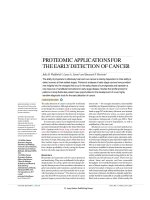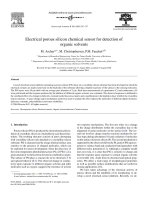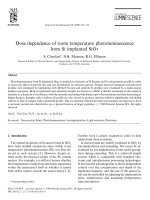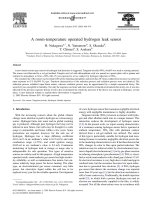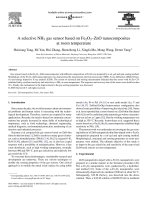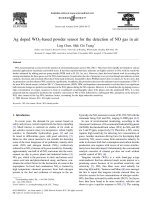- Trang chủ >>
- Khoa Học Tự Nhiên >>
- Vật lý
la nanotubes sensor for room temperature detection of ammonia
Bạn đang xem bản rút gọn của tài liệu. Xem và tải ngay bản đầy đủ của tài liệu tại đây (647.54 KB, 4 trang )
Sensors and Actuators B 134 (2008) 62–65
Contents lists available at ScienceDirect
Sensors and Actuators B: Chemical
journal homepage: www.elsevier.com/locate/snb
La
0.5
Sr
0.5
CoO
3−ı
nanotubes sensor for room temperature detection of ammonia
Wei Liu
a,b,c
, Sheng Wang
a
, Yu Chen
a
, Guojia Fang
a,b,c
, Meiya Li
a,b,c
, Xing-zhong Zhao
a,b,c,∗
a
Department of Physics, Wuhan University, Wuhan 430072, People’s Republic of China
b
Key Laboratory of Acoustic and Photonic Materials and Devices of Ministry of Education, Wuhan University, Wuhan 430072, People’s Republic of China
c
Center of Nanoscience and Nanotechnology, Wuhan University, Wuhan 430072, People’s Republic of China
article info
Article history:
Received 26 November 2007
Received in revised form 13 April 2008
Accepted 14 April 2008
Available online 30 April 2008
Keywords:
LSCO nanotubes
Gas sensors
Fast response
abstract
La
0.5
Sr
0.5
CoO
3−ı
(LSCO) nanotubes were synthesized by using a porous anodic aluminum oxide (AAO)
template from a sol–gel solution.Based on theachievement of synthesis ofLSCO nanotubes, ananotube gas
sensor was fabricated with microelectromechanical system technology andits NH
3
sensing characteristics
were investigated. Capacitanceof LSCO nanotubes was changed by two orders of magnitude withinseveral
seconds of exposure to NH
3
molecules at room temperature. The detection limit of the LSCO nanotube
sensor was several ppm,and the typicalresponse and recovery timeof the sensorat room temperature was
only several seconds. Our results demonstrate the potential application of LSCO nanotubes for fabricating
a highly sensitive and fast response gas sensor.
© 2008 Elsevier B.V. All rights reserved.
1. Introduction
Recently, one-dimensional (1-D) nanostructures, including
semiconducting carbon nanotubes [1,2], functionalized carbon
nanotubes [3,4], Si nanowires [5,6], ZnO nanowires [7],V
2
O
5
nanowires [8],In
2
O
3
nanowires [9,10],WO
3
nanowires [11], SnO
2
nanowires [12], and metal nanowires [13,14], have been demon-
strated as effective ultrasensitive chemical and biological sensors
because of their high surface-to-volume ratio and their unique
electrical properties. These features may enable a sensitivity high
enough to charged analytes so that single molecule detection
becomes possible [15]. In addition, the direct conversion that from
chemical information into electrical signal can take advantage of
existing low-power microelectronic technology and lead to minia-
turized sensor devices.
The recovery time is a very important parameter for gas sensors.
Most of the nanotube based gas sensors have slow recovery time
ranging from several minutes to several hours [1,11,12,16], which
limits the practical application of these sensors. Some assistant
methods, such as UV irradiation and high voltage pulse [11,16,17]
are used to decrease the recovery time, but these assistant methods
also make the sensors inconvenient to use. In this letter we report
a fast recover gas sensor based on LSCO nanotubes. Our devices
exhibit a large response to NH
3
at room temperature. Moreover,
∗
Corresponding author at: Department of Physics, Wuhan University, Wuhan
430072, People’s Republic of China.
E-mail address: (X z. Zhao).
Response time as short as several seconds has also been achieved,
which is far better than the results previously obtained [1,11,12,16].
2. Experiment methods
2.1. AAO membrane preparation
High-purity aluminum sheets (99.999%, 20 mm × 10 mm) were
used in this experiment. Prior to anodization, the metal surfaces
were degreased, etched in an alkaline solution, rinsed in distilled
water, and electropolished to achieve a smooth surface. It was nec-
essary to immerse the samples in a concentrated acid or alkaline
solution for several minutes to remove the oxide layer formed
during the electropolishing process. All samples were rinsed in dis-
tilled water again and then transferred to a nitrogen environment.
The resultant clean aluminum samples were anodized at constant
potential in 0.3 M oxalic acid (C
2
H
2
O
4
) (40 V, 4
◦
C, Pt sheet as a
counter electrode). The anode was then immersed in an aqueous
solution of 0.6 M H
3
PO
4
and 0.15 M H
2
CrO
4
at 60
◦
C for 10 h to
remove the alumina layer. Subsequently, the Al sheet was rean-
odized for 20 h under the same condition again and became an AAO
template with highly ordered nanoporous arrays.
2.2. LSCO sol preparation
The LSCO sol were prepared from the starting materials
of lanthanum acetate (La(CH
3
COO)
3
·1.5H
2
O), strontium acetate
(Sr(CH
3
COO)
2
·0.5H
2
O) and cobalt acetate (Co(CH
3
COO)
2
·4H
2
O).
The starting materials were mixed at a molar ratio of La:Sr:Co
0925-4005/$ – see front matter © 2008 Elsevier B.V. All rights reserved.
doi:10.1016/j.snb.2008.04.034
W. Liu et al. / Sensors and Actuators B 134 (2008) 62–65 63
Fig. 1. Apparatus for gas sensing test.
=1− x:x:1 and dissolved in heated acetic acid and deionized
water; acetylacetone (CH
3
COCH
2
COCH
3
) was added to stabilize the
solution at a the volume ratio of CH
3
COCH
2
COCH
3
/H
2
O =1:1). For-
mamide (HCONH
2
) was also added to the system at a volume ratio
of HCONH
2
/H
2
O =1:3) in order to avoid cracking during heating.
The concentration of solution was diluted to 0.3 M Co.
2.3. LSCO nanotubes preparation
The alumina template membrane was dipped into the sol for
a desired period of time and then removed, the excess sol on the
membrane surface was wiped off using a laboratory tissue,followed
by drying under vacuum at 100
◦
C for 24 h. The membrane surface
was carefully wiped again to remove salts crystallized on the sur-
face and heated at 700
◦
C for 4 h in open air, resulting in formation
of arrays of LSCO nanotubes in the inside of the pores of the AAO
template.
2.4. Characterization
The morphologies of the LSCO nanowires were characterized by
a scanning electron microscope (SEM, Sirion FEG, FEI).
For the capacitance measurement, a pair of interdigitated elec-
trodes (IDE) was fabricated using a conventional photolithographic
method with a finger width of 8 m and a gap size of 8 m. The IDE
fingers were made by sputtering 20-nm Ti and 40-nm Pt on a layer
of silicon dioxide (SiO
2
) thermally grown on top of a silicon wafer.
The suspension of LSCO was strewn on the IDE fingers.
2.5. Measurement of sensing characteristics
Gas-sensing experiments were carried out using a capacitance
measurement system, as represented in Fig. 1. During the experi-
ment, an LSCO nanotube gas sensor was placed in a sealed chamber.
Diluted NH
3
in a carrier gas of air flowed through the sealed cham-
ber while we are monitoring the capacitance and dielectric loss
of the LSCO nanotubes. All measurements were operated at room
temperature. The capacitance and dielectric loss responses during
testing were monitored by a precision impedance analyzer (Agilent
4294a).
3. Results and discussions
Fig. 2 illustrates the SEM images of LSCO nanotubes on micro-
electrodes. It can be seen in Fig. 2, the diameter of the LSCO
Fig. 2. SEM image of LSCO nanotubes on Au microelectrodes.
nanotubes is about 50 nm, which is similar to the pore diameter
of the template. These LSCO nanotubes are put over two Pt/Ti elec-
trodes.
The capacitive NH
3
sensing properties of LSCO nanotubes were
measured at room temperature by placing the device in a testing
chamber. Exposure to NH
3
molecules increased the capacitance of
the sensor (Fig. 3). It has been found that there exists a dependency
of the capacitance on the applied signal frequency. Clearly, the
device’s response to NH
3
gas was more sensitive at lower frequency.
A capacitance change of about three orders of magnitude had been
achieved to 1000 ppm NH
3
at a frequency of 100 Hz. However, the
noise at low frequency was not neglected. Therefore 10,000 Hz was
chosen as the applied signal frequency to obtain enough sensitivity
and negligible noise. The dielectric loss versus frequency in dif-
ferent concentrations of NH
3
is depicted in Fig. 4. When the NH
3
concentration increased, the resonant frequency shifts from low to
high frequency, which is corresponding to faster ion transport in
high NH
3
concentration of NH
3
.
Typical response curve obtained with different steps ofNH
3
con-
centration variation at the 10,000 Hz frequency is reported in Fig. 5;
the measurements were performed at room temperature. After
0.5% NH
3
was induced, the capacitance of the PAA sample increased
by about three orders of magnitude (Fig. 5a). And then the NH
3
con-
centration decreased by 20% in every step. The capacitance of the
device decreased along with the decreasing NH
3
concentration.
The capacitanceand dielectric loss variation versus NH
3
concen-
tration was measured for the same device and the plots are shown
Fig. 3. Capacitance of LSCO nanotubes versus frequency at different NH
3
concen-
trations.
64 W. Liu et al. / Sensors and Actuators B 134 (2008) 62–65
Fig. 4. Dielectric loss of LSCO nanotubes versus frequency at different NH
3
concen-
trations.
Fig. 5. (a) Capacitance and (b) dielectric loss responses to the stepwise decreases of
the NH
3
concentration at a frequency of 10,000 Hz.
in Fig. 6. From the plot we can see that the capacitance of the device
increases along with the increasing NH
3
concentration. It is clearly
evident that the LSCO nanotube sensor exhibits a greater sensitiv-
ity towards NH
3
. The detection limit of the LSCO nanotube sensor
is several ppm. The capacitance varied with the NH
3
concentration
monotonically but nonlinearly, while the dielectric loss was non-
monotonically related to the NH
3
concentration. When the NH
3
Fig. 6. The plots of (a) and (b) dielectric loss variation as a function of NH
3
concen-
tration at a frequency of 10,000 Hz.
Fig. 7. (a) Capacitance and (b) dielectric loss changes at 10,000 Hz upon exposure
to NH
3
of 10–200 ppm.
concentration is lower than 200 ppm, the dielectric loss increased
with increasing NH
3
concentration. However, in the range from 200
to 1000 ppm, thedielectric loss decreased with increasing NH
3
con-
centration. These results matched well with the data in Fig. 4.In
Fig. 4, the points on the dashed line correspond to dielectric losses
at 10,000 Hz. We can see that the dielectric loss peak is obtained to
about 200 ppm of NH
3
, which corresponds to the peak in curve (b)
in Fig. 6.
To understand the sensitivity in low NH
3
concentration, the
dynamics gas response of the LSCO nanotube sensor to low con-
centrations of NH
3
is shown in Fig. 7. Curves (a) and (b) represent
how thecapacitance and dielectricloss responses to NH
3
of 200, 50,
30, 20 and 10 ppm, respectively. The variation amplitudes at vari-
ous NH
3
concentrations could be reflected clearly by the functionof
device sensitivity. We define capacitance response (S
C
) as the ratio
S
C
=((C
A
− C
G
)/C
A
) × 100%, where C
A
represents the capacitance in
air and C
G
the capacitance in gas. The dielectric loss response (S
D
)
is defined as the ratio S
D
=((D
A
− D
G
)/D
A
) × 100%, where D
A
rep-
resents the dielectric loss in air and D
G
the dielectric loss in gas.
We can see that the capacitance response is 126, 61, 33, 16 and
12%toNH
3
of 400, 100, 50, 30 and 20 ppm respectively, while the
dielectric loss response is 337, 220, 168, 112 and 80%. The dielectric
loss response is much higher than the capacitance response. These
results are in good accordance with the data in Fig. 6.
Response time is one of the most important parameters for all
sensors. Generally, this property of a gas sensor mainly depends
upon the response time at low gas concentrations. The room-
temperature response and recovery time of the LSCO nanotube
sensor at low NH
3
concentrations are presented in Fig. 7. The exper-
imental data showed that about only several seconds was needed
for the capacitance to reach 90% of the total variation values dur-
ing both NH
3
adsorption and desorption processes, These results
were far better than most of other 1-D nanostructrued materials
[1 ,11,12,16].
The sensing mechanism of LSCO nanotubes to NH
3
was sug-
gested to be related with the change of the overall dielectric
constant or a surface reaction process. The capacitance and dielec-
tric loss variation with NH
3
of LSCO nanotubes may have originated
mainly from theNH
3
molecule adsorption on the walls of LSCO nan-
otubes, replacement of the air in the voids of the nanopores by NH
3
vapors, and possible surface reaction. The fast response and recov-
ery time may be due to the physical adsorption of NH
3
on the LSCO
nanotube surface.
W. Liu et al. / Sensors and Actuators B 134 (2008) 62–65 65
4. Conclusions
La
0.5
Sr
0.5
CoO
3
(LSCO) nanotubes were synthesized using a
porous anodic aluminum oxide (AAO) template from a sol–gel
solution. The ammonia response of LSCO nanotubes was tested.
The experiments showed that the LSCO sensor exhibited a large
response to NH
3,
quick response and recovery time, and reversibil-
ity at room temperature. These excellent NH
3
sensing properties
were attributed to the high surface-to-volume ratio of the 1-D
nanostructured materials. Thus, it is strongly indicated that LSCO
nanotubes are a promising practical NH
3
sensing material.
Acknowledgement
This work was supported by National Key Basic Research
and Development Program (973 Project) of China (Grant No.
2006CB932305).
References
[1] E.S. Snow, F.K. Perkins, E.J. Houser, S.C. Badescu, T.L. Reinecke, Chemical detec-
tion with a single-walled carbon nanotube capacitor, Science 307 (2005)
1942–1945.
[2] J. Kong, N.R. Franklin, C.W. Zhou, M.G. Chapline, S. Peng, K.J. Cho, H.J. Dai, Nan-
otube molecular wires as chemical sensors, Science 287 (200 0) 622–625.
[3] K. Besteman, J.O. Lee, F.G.M. Wiertz, H.A. Heering, C. Dekker, Enzyme-coated
carbon nanotubes as single-molecule biosensors, Nano Lett. 3 (2003) 727–730.
[4] J. Kong, M.G. Chapline, H.J. Dai, Functionalized carbon nanotubes for molecular
hydrogen sensors, Adv. Mater. 13 (2001) 1384–1386.
[5] W.W. Chen, H. Yao, C.H. Tzang, J.J. Zhu, M.S. Yang, S.T. Lee, Silicon nanowires for
high-sensitivity glucose detection, Appl. Phys. Lett. 88 (2006) 213104–213106.
[6] Z. Li, Y. Chen, X. Li, T.I. Kamins, K. Nauka, R.S. Williams, Sequence-specific label-
free DNA sensors based on silicon nanowires, Nano Lett. 4 (2004) 245–247.
[7] Q. Wan, Q.H. Li, Y.J. Chen, T.H. Wang, X.L. He, J.P. Li, C.L. Lin, Fabrication and
ethanol sensing characteristics of ZnO nanowire gas sensors, Appl. Phys. Lett.
84 (2004) 3654–3656.
[8] H.Y. Yu, B.H. Kang, U.H. Pi, C.W. Park, S.Y. Choi, G.T. Kim, V
2
O
5
nanowire-
based nanoelectronic devices for helium detection, Appl. Phys. Lett. 86 (2005)
253102–253104.
[9] D.H. Zhang, Z.Q. Liu, C. Li, T. Tang, X.L. Liu, S. Han, B. Lei, C.W. Zhou, Detection of
NO
2
down to ppb levels using individual and multiple In
2
O
3
nanowire devices,
Nano Lett. 4 (2004) 1919–1924.
[10] D.J. Zhang, C. Li, X.L. Liu, S. Han, T. Tang, C.W. Zhou, 2003 Doping depen-
dent NH
3
sensing of indium oxide nanowires, Appl. Phys. Lett. 83 (2003)
1845–1847.
[11] Y.S. Kim, S.C. Ha, K. Kim, H. Yang, S.Y. Choi, Y.T. Kim, J.T. Park, C.H. Lee, J.
Choi, J. Paek, K. Lee, Room-temperature semiconductor gas sensor based on
nonstoichiometric tungsten oxide nanorod film, Appl. Phys. Lett. 86 (2005)
213105–213107.
[12] A. Kolmakov, Y.X. Zhang, G.S. Cheng, M. Moskovits, Detection of CO and O
2
using
tin oxide nanowire sensors, Adv. Mater. 15 (2003) 997–1000.
[13] F. Favier, E.C. Walter, M.P. Zach, T. Benter, R.M. Penner, Hydrogen sensors and
switches from electrodeposited palladium mesowire arrays, Science 293 (2001)
2227–2231.
[14] B.J. Murray, E.C. Walter, R.M. Penner, Amine vapor sensing with silver
mesowires, Nano Lett. 4 (2004) 665–670.
[15] A. Kolmakov, M. Moskovits, Chemical sensing and catalysis by one-
dimensional metal-oxide nanostructures, Annu. Rev. Mater. Res. 34 (200 4 )
151–180.
[16] C. Li, D.H. Zhang, X.L. Liu, S. Han, T. Tang, J. Han, C.W. Zhou, In
2
O
3
nanowires as
chemical sensors, Appl. Phys. Lett. 82 (2003) 1613–1615.
[17] Z.Y. Fan, J.G. Lu, Gate-refreshable nanowire chemical sensors, Appl. Phys. Lett.
86 (2005) 123510–123512.
Biographies
Wei Liu received his MS degree in physics at Wuhan University in 2003 and presently
is a graduate student for her PhD degree in physics at Wuhan University. Her field
of interest is nanomaterials and Lab on a Chip.
Sheng Wang received his MS degree in physics at Wuhan University in 2005 and
presently is a graduate student for her PhD degree in physics at Wuhan University.
His field of interest is nanomaterials and devices.
Yu Chen received his BSdegree inphysics at Wuhan University in 2007 and presently
is a graduate student for his MS degree in physics at Wuhan University.
Meiya Li received his PhD in physics at Beijing University in China (1997) and
presently is a professor in Department of Physics of Wuhan University. His current
fields of interest are nanomaterials.
Guojia Fang received his PhD in physics at Huazhong University of Science and
Technology in China (2000) and presently is a professor in Department of Physics of
Wuhan University. His current fields of interest are nanomaterials
Xing-Zhong Zhao received his PhD in physics at University of Science and
Technology of Beijing in China (1989) and presently is a professor in Depart-
ment of Physics of Wuhan University. His current fields of interest are Lab on a
Chip.



